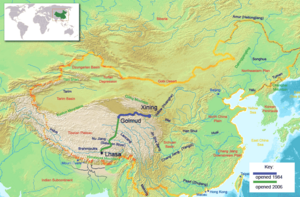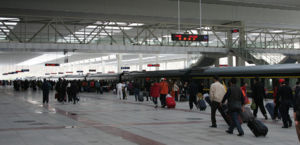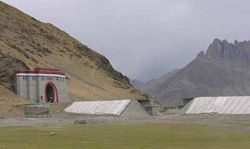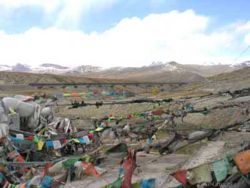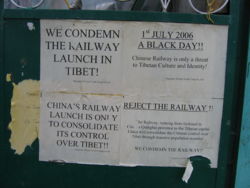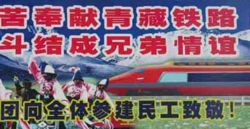Qingzang railway
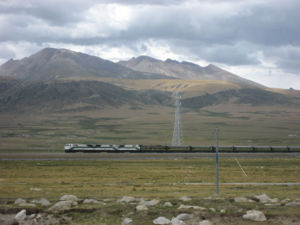
The Qingzang railway, Qinghai–Xizang railway, or Qinghai–Tibet railway (Simplified Chinese: 青藏铁路; Traditional Chinese: 青藏鐵路; pinyin: Qīngzàng Tiělù), is a high-altitude railway that connects Xining, Qinghai Province, to Lhasa, Tibet Autonomous Region, in the People's Republic of China.
The section of the railway between Golmud and Lhasa was inaugurated on 1 July 2006 by president Hu Jintao: the first two passenger trains were "Qing 1" (Q1) from Golmud to Lhasa, and "Zang 2" (J2) from Lhasa.[1] This railway is the first to connect China proper with the Tibet Autonomous Region, which due to its altitude and terrain is the last province-level entity in the People's Republic of China to have a conventional railway. Testing of the line and equipment had started on May 1 2006.[2] Trains run from Beijing, Chengdu, Chongqing, Xining and Lanzhou.[3]
The line includes the Tanggula Pass, at 5,072 m above sea level the world's highest rail track.
The 1,338 m Fenghuoshan tunnel is the highest rail tunnel in the world, at 4,905 m above sea level. The 3,345-m Yangbajing tunnel is the longest tunnel of the line. It is 4,264 m above sea level, 80 kilometres NW of Lhasa.
More than 960 km, or over 80% of the railway, is at an altitude of more than 4,000 m. There are 675 bridges, totalling 159.88 km, and over half the length of the railway is laid on permafrost.
Contents
Stations
Qingzang railway/Map Forty-five stations are open, 38 are which unstaffed, monitored in the control center in Xining. Thirteen 13 stations are planned. [4] Of the 45 stations,
Trains and tickets
The trains are specially built for high altitude environment. The diesel locomotives used on Golmud-Lhasa section are made by GE in Pennsylvania, and the passenger carriages are Chinese-made 25T carriages: on train T27/T28, between Beijing West and Lhasa, BSP carraiages are from Bombardier. Carriages used on Golmud-Lhasa section are either deep green/yellow or deep red/yellow. Signs used in the carriages are in Tibetan, Simplified Chinese, and English. The operational speed is 120 km/hr, 100 km/hr in sections laid on permafrost.
The 1,142-km Qinghai–Tibet railway from Golmud to Lhasa was completed on October 12 2005. The new section of track opened to regular trial service on July 1, 2006.[5] During this 1-year trial period, three passenger trains ran from Beijing, Chengdu/Chongqing, and Xining/Lanzhou, numbered T27/T28, T22/T23/T24/T21, T222/T223/T224/T221, N917/N918, K917/K918, respectively. Train T27 from Beijing to Lhasa takes 47 hours 28 minutes, covering 4,064 km (2,500 miles), departs at 21:30 from Beijing West, and arrives in Lhasa at 20:58 on the third day. A ticket costs CNY¥ 389 for hard seat, CNY¥ 813 for a lower hard sleeper (a lower bunk in a basic sleeping car), or CNY¥ 1,262 for a lower soft sleeper (a bunk in a more luxurious sleeping car). T28 from Lhasa to Beijing West departs at 08:00 and arrives in Beijing at 08:00 on the third day, takes 48 hours.
Apart from hard seat tickets, there is an extra charge for forward-facing seats/berths. Compared with standard pricing for the same class, the soft seat, hard sleeper and soft sleeper tickets will have an added charge of 0.09, 0.10 or 0.16 yuan per kilometre per person respectively.
Trains from Shanghai and Guangzhou started on October 1 2006. Train T264/5 from Guangzhou departs at 10:29 every other day and arrives in Lhasa at 19:50 on the third day, while T266/3 (from 4 October 2006) departs Lhasa at 08:32 and arrive in Guangzhou at 19:37 on the third day. Trains T164/5 from Shanghai to Lhasa depart at 16:11 from Shanghai, via Wuxi, Nanjing, Bengbu, Zhengzhou, Xi'an, Lanzhou, Xining, Golmud, Nagqu, arrive in Lhasa at 19:50 on the third day. Trains T166/3 from Lhasa to Shanghai depart at 08:32 and arrive in Shanghai at 13:45 on the third day.
A Passenger Health Registration Card is required to take the train. The card can be obtained when purchasing the ticket. Passengers must read the health notice for high-altitude travel and sign the agreement on the card to take the train. On August 28 2006 a 75-year-old Hong Kong man was reported to be the first passenger to die on the train, after he had suffered heart problems in Lhasa but insisted on travelling to Xining. [3] On November 19 2006 a woman died giving birth to a child on her own in a toilet.
Tticket prices for 5-carriage trains in the testing period were as follows: (Unit: Chinese Yuan)
| Train | From/To | Kilometres | Hard Seat | Hard Sleeper (lower berth) | Soft Sleeper (lower berth) |
|---|---|---|---|---|---|
| T27/28 | Beijing west - Lhasa | 4064 | 389 | 813 | 1262 |
| T22/23/24/21 | Chengdu - Lhasa | 3360 | 331 | 712 | 1104 |
| T222/223/224/221 | Chongqing - Lhasa | 3654 | 355 | 754 | 1168 |
| T164/5 | Shanghai - Lhasa | 4373 | 406 | 845 | 1314 |
| T166/3 | Lhasa - Shanghai | 4373 | 406 | 845 | 1314 |
| T262 | Guangzhou - Lhasa | 4980 | 451 | 923 | 1434 |
| T264 | Lhasa - Guangzhou | 4980 | 451 | 923 | 1434 |
| K917/K918 | Lanzhou - Lhasa | 2188 | 242 | 552 | 854 |
| N917/N918 | Xining - Lhasa | 1972 | 226 | 523 | 810 |
Oxygen supply
From October 2006 five pairs of passenger trains run between Golmud and Lhasa, and one pair run between Xining and Golmud. The line has a capacity of eight pairs of passenger trains, and the carriages are special built and have an oxygen supply for each passenger.
Construction
Since the formation of the Tibetan Autonomous Region in early 1950s, the Chinese central government has dreamed of building a railway connecting Tibet to the rest of China. Engineers were sent to investigate the possibility, but shortage of technology and money prevented the project from starting.
The 815 km section from Xining, Qinghai to Golmud, Qinghai opened to traffic in 1984. Construction of the remaining 1,142 km section from Golmud to Lhasa, could not be started until the recent economic growth of China. This section was formally started on 29 June 2001. This section was finished on October 12, 2005, and signalling work and track testing took another eight months. It was completed in five years at a cost of $3.68 billion.
Rail-laying in Tibet was launched from both directions, towards Tanggula Mountain and Lhasa, from Anduo Railway Station on 22 June 2004. On 24 August 2005, track was laid at the railway's highest point, the Tanggula Pass, 5,072 m (16,640 feet) above sea level.[6]
Forty-four railway stations are to be built, among them Tanggula Mountain railway station, at 5,068 m the world's highest (Cóndor station, at 4,786 m, on the Rio Mulatos-Potosí line, Bolivia, and La Galera station at 4,781 m in Peru, being the next highest) The Qingzang Railway project involved more than 20,000 workers and over 6,000 pieces of industrial equipment, and is considered one of China's major accomplishments of the 21st century.
Bombardier Transportation provided 361 high-altitude passenger carriages with special enriched-oxygen and UV-protection systems, delivered between December 2005 and May 2006. Fifty-three are luxury sleeper carriages for tourist services.[7]
The construction of the railway was part of the China Western Development strategy, an attempt to develop the western provinces of China, which are much less developed than eastern China. The railway will be extended to Zhangmu via Shigatse (日喀则) to the west, and Dali via Nyingchi (林芝) to the east. A further extension is planned to link Shigatse with Yadong near the China-India border [8] (Map [9]).
Engineering challenges
There were and are many technical difficulties for such a railway.
About half of the second section was built on barely permanent permafrost. In the summer, the uppermost layer thaws, and the ground becomes muddy. Chinese engineers dealt with this problem by building elevated tracks with foundations sunk deep into the ground, inserting vertical pipes that circulate liquid nitrogen and cold nitrogen gas into the ground, building hollow concrete pipes beneath the tracks to keep the rail bed frozen, and using metal sun shades.[10] However, global warming may require new methods to be invented in the coming decades to keep this railway operating.
The air in Tibet is much thinner, having 35% to 40% of the oxygen of air at sea level, and therefore special passenger rail cars must be used, and several oxygen factories were built along the railway. At this altitude, ballpoint pens can explode[citation needed] and water in toilets must be heated to prevent freezing. The Chinese government claimed that no construction worker died during the construction due to altitude sickness related diseases. [11] The railway passes the Kunlun Mountains, an earthquake zone. A magnitude 8.1 earthquake struck in 2001. Dozens of earthquake monitors have been installed along the railway.
Economic impact
With limited industrial capacity in Tibet, the Tibetan economy heavily relies on industrial products from more developed parts of China. Transportation of goods in and out of Tibet was mostly through the Qingzang Highway connecting Tibet to the adjacent Qinghai province, which was built in the early 1950s. The length and terrain have limited the capacity of the highway, with less than 1 million tons of goods transported each year. With the construction of the Qingzang railway, the cost of transportion of both passengers and goods should be greatly reduced, allowing for an increase in volume—the cost per tonne-kilometer will be reduced from 0.38 RMB to 0.12 RMB. It is projected that by 2010 2.8 million tons will be carried to and from Tibet will reach , with over 75% carried by the railway[12]. This is expected to boost and transform the Tibetan economy.
Environmental impact
The environmental impact of the new railway is an ongoing concern. Certainly the increase in passenger traffic will result in greater tourism and economic activity on the Tibetan Plateau.
Wood is the main fuel source for rural inhabitants in certain regions of Tibet. The damage to the ecosystem caused by cutting trees for fuel takes years to recover due to slow growth caused by Tibet's harsh environment condition. The railway would make coal, which is not produced in Tibet, an affordable replacement. However, the increase in fuel combustion due to increased human activity—in an already thin atmosphere—may affect the long term health of the local population.
Some people worried that railway passengers will throw trash out of train windows. This is unlikely, as all passenger cars will be sealed to enable oxygen enhancement once a train enters Tibet. Trash will be carried back to Golmud by trains to be processed.
The effects of this railway on wild animals such as Tibetan antelope and plants are currently unknown. Along the whole stretch of the railway, 33 overpasses were constructed specifically to allow continued animal migration, here is the Google Maps satellite image of one of such bridges.
Criticism
Opponents of China's Tibet policies claimed that the railway was built to strengthen its political control over Tibet despite doubts over the railway's economic viability, and that more money has been spent on it than on healthcare and education in the Tibet Autonomous Region over the last five decades. [13]
The railway will encourage further immigration from the rest of China, reducing the proportion of Tibetans in the Tibet Autonomous Region. Tibetans find it increasingly difficult to compete in the job market against skilled Han workers (most of the workers on the railway were of the Han ethnicity).[14] Tibetans and activist groups have also expressed concerns that the Chinese government will use the railway to strengthen its military presence in the Tibet Autonomous Region as well as to further exploit Tibet's natural resources and damage its environment. As a result, Bombardier Transportation, a Canadian company, has faced international criticism from some pro-independence organizations for its involvement in constructing rail cars for the project.[15][16][17]
Fleet
- 361 Bombardier Sifang Power (Qingdao) Transportation Ltd./Power Corporation of Canada/China South Locomotive and Rolling Stock Industry (Group) Corporation High-Grade Coach - 308 standard cars and 53 special tourist cars
- GE Transportation NJ2 locomotive (possible 78 locomotives were built)
- Qishuyang Locomotive Factory DF8CJ 9000 series locomotive - similar to the Bombardier Transportation-GE Transportation Blue Tiger diesel electric locomotive
Media
-
Nagqu railway station (file info)
- A train approaching at Naqu railway station in Tibet. (15.46 MB, ogg/Theora format).
-
Fenghuoshan tunnel (file info)
- A journey through the world's highest railway tunnel. (5.41 MB, ogg/Theora format).
- Problems seeing the videos? See media help.
See also
References
- M.W.H., Railroad in the clouds, Trains March 2002
- ↑ [1] Report of inauguration, accessed July 1, 2006
- ↑ Shanglin, Luan, editor. "Tibet's 1st railway to start unmanned operation", Xinhua, 2006-04-13. Retrieved on 2006-04-14.
- ↑ China Tibet Information Center. Shanghai strives for straight train to Lhasa. Retrieved April 7, 2006.
- ↑ http://news.sina.com.cn/c/2006-07-01/193210306837.shtml
- ↑ China rolls out railway, BBC News. Retrieved June 30, 2006.
- ↑ Xinhua News Agency (August 24, 2005). New height of world's railway born in Tibet. Retrieved August 25, 2005.
- ↑ Bombardier (February 25, 2005). Bombardier Awarded A Contract For High Altitude Passenger Rail Cars In Tibet. Retrieved August 25 2005.
- ↑ Extension plans. Retrieved June 28, 2006
- ↑ http://sun-bin.blogspot.com/2006/07/qinghai-tibet-railway-videos.html
- ↑ Wired Magazine Issue 14.07. [2]
- ↑ News on Chinese government website (in Chinese) quotes: The vice president of Qinghai Medical University, Dr. Gerili said "Because of proper preventions and treatments, among tens of thousands of workers from low altitude, no one died due to altitude sickness. You cannot deny that it's a miracle."
- ↑ News - Qingzang railway transported .73M passengers, boosts Tibet economy, in chinese
- ↑ http://www.savetibet.org/news/newsitem.php?id=497
- ↑ http://www.chinapost.com.tw/asiapacific/detail.asp?ID=84633&GRP=C
- ↑ http://www.bombardieroutoftibet.org
- ↑ http://actionnetwork.org/sft/alert-description.tcl?alert_id=3492803
- ↑ http://www.tibet.ca/en/wtnarchive/2005/6/18_3.html
External links
- Railway map of China
- Environmental Protection Along the Qinghai-Tibet Railway, US Embassy report
- The Guardian, 20 September 2005, "The railway across the roof of the world"
- Wired Magazine, July 2006, "Train to the Roof of the World"
- Tibet railway construction
- Tibet railway videos
- Actual Images published in the Wired Magazine
- CCTV report regarding the railroad
- A train travelling near the Tsonag Lake, Cuonahu railway station. [4] [5] [6]
bg:Цинхай-тибетска железница de:Lhasa-Bahn es:Ferrocarril Qinghai–Tíbet eo:Ĉinghaj-Tibeta fervojo fr:Ligne ferroviaire Qing-Zang it:Ferrovia del Qingzang he:רכבת צ'ינגזאנג nl:Peking-Lhasa-spoorweg ja:青蔵鉄道 pl:Kolej tybetańska ru:Цинхай-Тибетская железнодорожная магистраль sh:Željeznička pruga Qingzang fi:Tiibetin rata zh:青藏铁路
